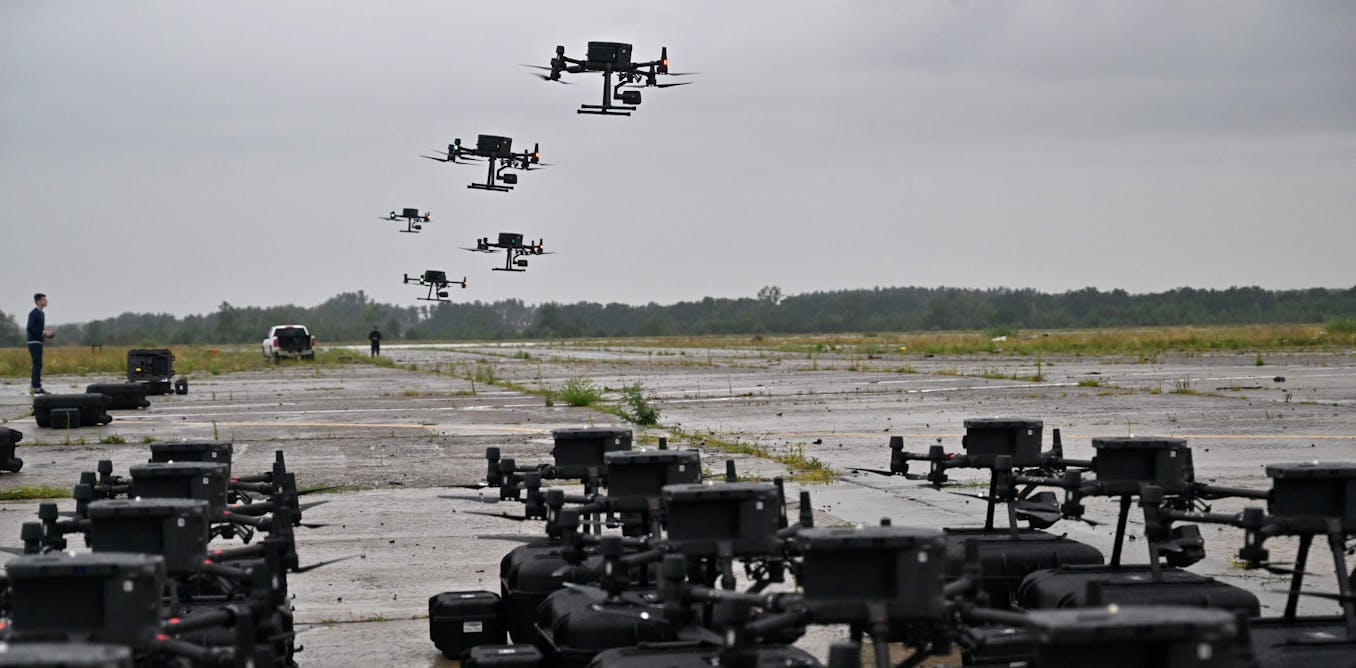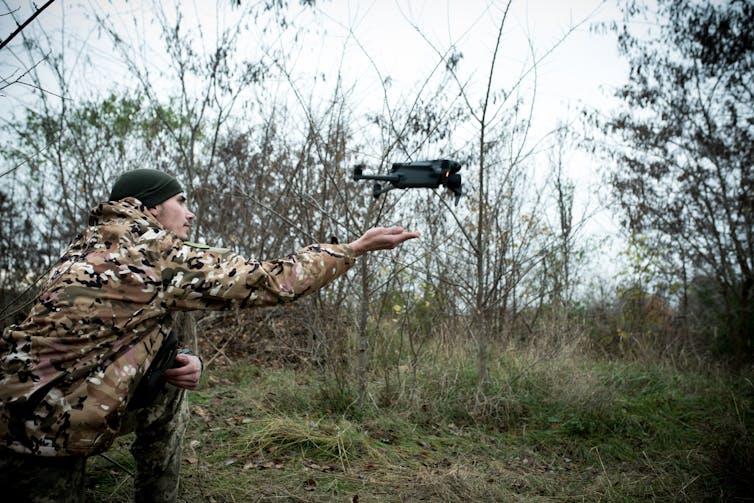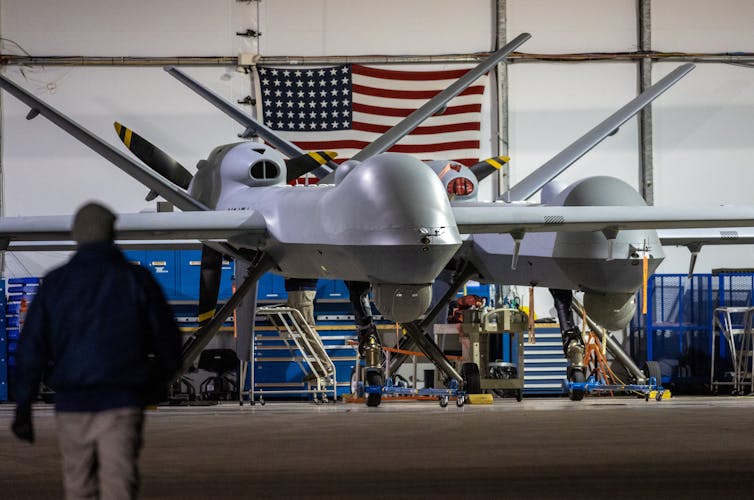Military drones are swarming the skies of Ukraine and other conflict hot spots – and anything goes when it comes to international law


Loud explosions rock the evening sky. Streaks of light appear like comets. Missiles rain down. Below, people scramble for cover. The injured are taken on stretchers – the dead, buried.
That is daily life in Ukraine, where pilotless vehicles known as drones litter the sky in an endless video gamelike – but actually very real – war with Russia.
Both Russia and Ukraine are using drones in this war to remotely locate targets and drop bombs, among other purposes.
Today, drones are used in various other conflicts, but are also used to deliver packages, track weather, drop pesticides and entertain drone hobbyists.
Welcome to the world of drones. They range from small consumer quadcopters to remotely piloted warplanes – and all types are being used by militaries around the world.
As a scholar of public diplomacy and foreign policy – and a former United States under secretary of state for public diplomacy and public affairs – I know how important it is for people to understand drones and their proliferation, given the risks of war, terrorism and accidental drone clashes in the world today.
 A Ukrainian soldier launches a drone from his hand in November 2022 in Zaporizhzhia, Ukraine. Elena Tita/Global Images Ukraine via Getty Images
A Ukrainian soldier launches a drone from his hand in November 2022 in Zaporizhzhia, Ukraine. Elena Tita/Global Images Ukraine via Getty Images
A buying spree
The U.S. is among more than 100 countries using drones in times of conflict.
Terrorists have also been known to deploy drones because they are relatively low-cost weapons with high degrees of civilian damage.
Consumer drone shipments, globally, topped 5 million units in 2020 and are expected to surpass 7 million by 2025.
Sales of drones globally were up 57% from 2021 to 2022.
With the exponential rise in drone purchases, there are few constraints for buyers, creating a wild, wild west of uncontrolled access and usage.
Each country is free to decide when and where drones fly, without answering to any other country or international authority governing drones. The skies are often filled with drone swarms, with little on-the-ground guidance on the rules of the sky.
Different purposes
Each country has a unique interest in getting and using drones.
China is increasingly using sophisticated drones for covert surveillance, especially in international waters to patrol the disputed islands in the South China Sea. Its expanding drone program has influenced other countries like the U.S. to also invest more in the technology.
Turkey’s military has a highly sophisticated drone, the Bayraktar TB2, which is capable of carrying laser-guided bombs and small enough to fit in a flatbed truck.
The United Arab Emirates imports drones from China and Turkey to deploy in Yemen and Libya to monitor warlords in case conflict breaks out.
And South Korea is considering starting a special drone unit after it failed to respond to a recent North Korean drone incursion. When North Korea deployed five drones towards it southern neighbor in December 2022, South Korea had to scramble its fighter jets to issue warning shots.
No rules in the air
The countries with armed drones are individually navigating their own rules instead of an international agreed-upon set of regulations.
International law prohibits the use of armed force unless the United Nations Security Council authorizes an attack, or in the case of self-defense.
But short of launching a full war, drones can legally be deployed for counterterrorism operations, surveillance and other non-self defense needs, creating a slippery slope to military conflict.
Figuring out the national and international rules of the sky for drone usage is hard.
For 20 years, experts have tried to create international agreements on arms – and some countries supported an informal 2016 U.N. agreement that recommends countries document the import and export of unmanned aerial vehicles.
But these efforts never evolved into serious, comprehensive standards and laws that kept pace with technology. There are several reasons for that: To protect their national sovereignty, governments do not want to release drone data. They also want to avoid duplication of their technology and to maintain their market share of the drone trade.
 A MQ-9 Reaper drone awaits its next mission over the U.S.-Mexico border in November 2022. John Moore/Getty Images
A MQ-9 Reaper drone awaits its next mission over the U.S.-Mexico border in November 2022. John Moore/Getty Images
US and drones
For decades, the U.S. has wrestled with how to balance drone warfare as it became involved in overseas operations in Iraq, Afghanistan, Syria and other conflict zones.
The U.S. killed a top al-Qaida leader with a drone strike in Afghanistan in 2022.
But there have been other instances of drone strikes that resulted in unintended casualties and damage.
In 2021, The New York Times reported that a U.S. drone strike on a vehicle thought to contain an Islamic State bomb resulted in the deaths of 10 children – not three civilians, as the U.S. said might have happened.
There is scant public opinion research on how American feel about the use of drones overseas, which makes building public support for their military use difficult.
Drone dangers
Drone dangers are real. Many drone experts, including myself, believe it is unsafe for each country’s military to make its own decisions on drones with no rules guiding drone transfers, exports, imports and usage – and no major forum to discuss drones, as the technology continues to evolve.
Multiple drones can communicate with each other remotely, creating shared objectives rather than an individual drone path or pattern. Like a swarm of bees, these drones form a deadly and autonomous aerial army ripe for accidents.
With the advent of artificial intelligence and more sophisticated unmanned aerial vehicles, drones can change speed, altitude and targeting in seconds, making them even more difficult to track and investigate. Attacks can happen seemingly out of the blue.
In my view, the world needs new and consistent rules on drone usage for the decade ahead – better international monitoring of drone incursions and more transparency in the outcome of drone attacks.
Information about the impact of military use of drones is not just important for historical purposes, but also to engage societies in action and temper the impulse to engage in conflict. It is time to talk seriously about drones.





